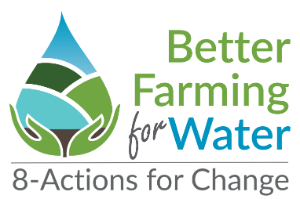Better farming for water
8 Actions for Change
 Launch of a national campaign aiming to support and accelerate the adoption of actions on all farms to improve all water bodies, where agriculture is a significant pressure, to Good or High ecological status.
Launch of a national campaign aiming to support and accelerate the adoption of actions on all farms to improve all water bodies, where agriculture is a significant pressure, to Good or High ecological status.
Download Publication (PDF)
Teagasc Water Quality Campaign – Introduction (pdf) – Professor Frank O’Mara, Director of Teagasc
Better Farming for Water – 8 Actions for Change (pdf) – Dr Daire Ó hUallacháin,
Environment, Soils & Land Use Department, Teagasc
Overview of Delivery – 6 Pillars (pdf) – Pat Murphy, Head of Environment & Knowledge Transfer, Teagasc
Building on the learnings from ASSAP. (pdf) – Fiona Doolan, Sustainability Advisor, Teagasc
Development and Utilisation of Digital Tools to Enable Better On-Farm Decision Making (pdf) – Dr Siobhán Jordan, Head of the Technology Transfer and CommercialisationNext Steps (pdf) – Professor Pat Dillon, Director of Research, Teagasc
Shane Fitzgerald is a dairy farmer in Portlaw, county Waterford. In this short video, Shane explains how he wants to leave the environment, and their farm and land in a better place than they got it.
Sean Sheridan is a drystock farmer and lives on the edge of Moynalty village. In this short video, Sean explains how on a visit from his ASSAP advisor, they walked the river bank on his farm and discussed some of the issues along the way. Sean decided to try and remove the cattle out of the river by installing a number of solar pumps to provide clean water to cattle and keep the river clean.
The Minister for Agriculture, Food and the Marine, Charlie McConalogue T.D., requested Teagasc to lead a multi-actor water quality advisory campaign to deliver clear, simple and positive messaging to enhance farmers’, as well as the broader agri-food industry’s understanding of the agriculture pressures on water quality and the need for improvement. As a result of this request, Teagasc has developed this document ‘Better Farming for Water’ to guide the campaign.
Agriculture in Ireland has a significant role to play in helping the country to achieve good water quality targets as set by the Water Framework Directive. However, farmers require technical support to increase their understanding of the impacts of farming on water quality and the actions to minimise the losses of nutrients, sediment and pesticides to water bodies. The ‘Better Farming for Water’ campaign will build on existing water quality programmes such as ACP, ACRES, ASSAP, Farming for Water EIP, Waters of LIFE, Blue Dot Catchments, Slaney project (and others) to improve water quality. The multi-actor (farmers, advisors/researchers, agri-food industry, community, government) approach to support farmers will ensure that challenges and solutions to address local water quality are delivered at farm, catchment and regional scale. This campaign is part of a wider whole-of-government approach to improve water quality.
The aim of the ‘Better Farming for Water’ campaign is to support and accelerate the adoption of actions on all farms to improve all water bodies (where agriculture is a significant pressure) to Good or High Ecological Status.
The objective of the ‘Better Farming for Water’ campaign will be to support all farmers to reduce the loads of nitrogen, phosphate, sediment and pesticides entering our river network through either diffuse or point source pathways from agricultural sources. This will be achieved through the on-farm adoption of 8-Actions for Change, which involve better nutrient, farmyard and land management.
These 8-Actions for Change provide a structured, relatable approach for farmers to effectively engage with improving water quality. They will help to advance the understanding of the need for actions, and instill confidence that the actions undertaken are worthwhile and will result in sustained, positive improvements in water quality.
The ‘Better Farming for Water’ campaign will be delivered by way of six key pillars: